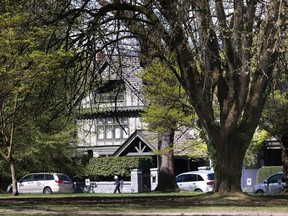Vancouver will need to update the zoning in the heritage neighbourhood of First Shaughnessy to comply with new provincial legislation, a new city staff report says.

Article content
One of Vancouver’s most exclusive, historic and sparsely populated neighbourhoods may soon need to make way for new types of denser, multi-unit housing projects.
This possible change on the way for Shaughnessy is one way the B.C. government’s new housing reforms could affect Vancouver, according to a report going to city council next week.
Article content
The new report includes Vancouver staff’s analysis on three pieces of legislation enacted by the B.C. government last November, which will, among other things, enable medium-density housing and bigger buildings around transit hubs in cities across B.C.
Advertisement 2
Article content
Since the province announced these changes last year, there have been many questions about their actual implementation. The new Vancouver report aims to provide more clarity for city council, the public, and property owners and developers. But, the report says, some key details are still to-be-determined — and council will have to make some decisions on these points in the coming months.
In recent months, city planners around B.C. have been working hard to craft new bylaws and reports by June to comply with the new legislation. There is a sense among many that these deadlines are forcing them to move very fast.
While some of the reforms may be more jarring for certain municipalities, Vancouver staff generally feel that this direction broadly aligns with the city’s priorities set by the current council and their recent predecessors: enabling so-called “missing-middle” medium density developments in the lowest density neighbourhoods, focusing greater density near transit, and boosting the supply of purpose-built rental housing in particular.
“All of these things are in line with what we want to do in Vancouver,” said Vancouver’s issues manager, Templar Tsang-Trinaistich. “They’re maybe a little out of order of how we would typically do things, and they’re coming with deadlines that are exceptionally fast … But it’s in line with where the city is going.”
Article content
Advertisement 3
Article content
Before the province announced plans to require cities to allow multi-unit developments in residential neighbourhoods, Vancouver changed its zoning last September to allow what the city calls “multiplexes” — developments with up to six units on a single lot — across almost all residential neighbourhoods. One notable exception to Vancouver’s medium-density zoning was the First Shaughnessy area, which is designated as a “heritage conservation area.”
Now, Vancouver will need to update First Shaughnessy’s zoning to comply with the provincial legislation, the new staff report says.
Even if multiplexes are legalized in Shaughnessy, it seems unlikely the market will produce many there, considering land prices. But it shows just one way that the provincial changes can over-ride existing municipal plans.
Another piece of provincial legislation will require cities to allow set minimum heights for residential developments close to transit hubs, including up to 20 storeys within 200 metres of a SkyTrain station and 12 storeys within 400 m.
When these changes were announced last year, some observers raised concerns that the push to densify around transit hubs could threaten historic Vancouver neighbourhoods like Chinatown, Gastown and Yaletown.
Advertisement 4
Article content
But the province’s new transit-oriented regulations will not necessarily over-ride council’s ability to control development in these heritage neighbourhoods, the Vancouver report says. That’s because, the report explains, while the legislation means cities can no longer reject a 20-storey apartment building above a SkyTrain station for being too tall, they can restrict development in other ways, or impose conditions such as affordability requirements.
“There may be circumstances where council may wish to include conditions to a development or refuse a rezoning application for other reasons beyond height and density,” the report says.
It will be up to council to decide which, if any, “other reasons” they might want to include for limiting such development. They could potentially include considerations such as heritage preservation and cultural context, which could apply to a place like Chinatown. Vancouver’s ABC-majority council has already signalled a desire to rethink some of the other considerations that have restricted Vancouver developments in the past, such as view protections or shadowing guidelines.
Advertisement 5
Article content
City council are only receiving this staff report next week for information. Decisions will be expected in June.
LIVE Q&A WITH B.C. PREMIER DAVID EBY: Join us April 23 at 3:30 p.m. when we will sit down with B.C. Premier David Eby for a special edition of Conversations Live. The premier will answer our questions — and yours — about a range of topics, including housing, drug decriminalization, transportation, the economy, crime and carbon taxes. Click HERE to get a link to the livestream emailed to your inbox.
Recommended from Editorial
Bookmark our website and support our journalism: Don’t miss the news you need to know — add VancouverSun.com and TheProvince.com to your bookmarks and sign up for our newsletters here.
You can also support our journalism by becoming a digital subscriber: For just $14 a month, you can get unlimited access to The Vancouver Sun, The Province, National Post and 13 other Canadian news sites. Support us by subscribing today: The Vancouver Sun | The Province.
Article content






